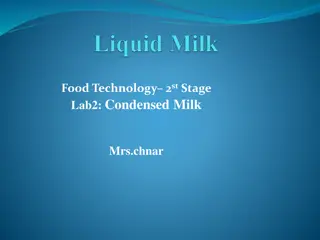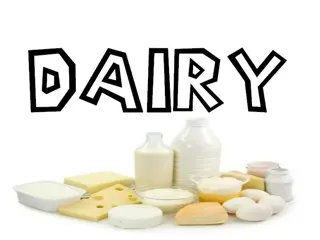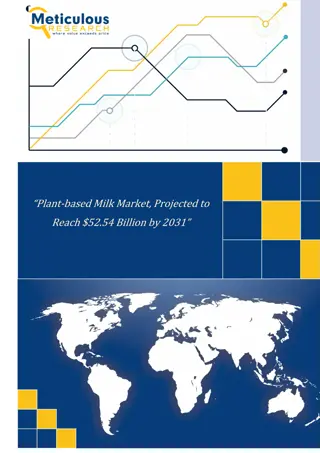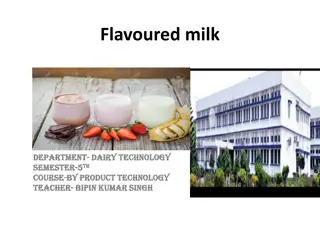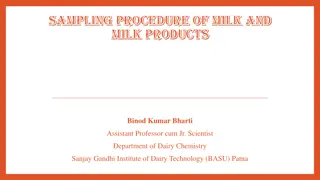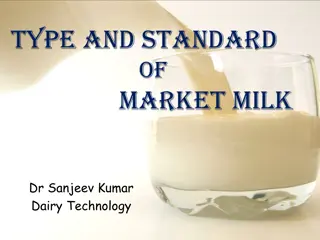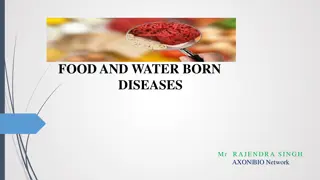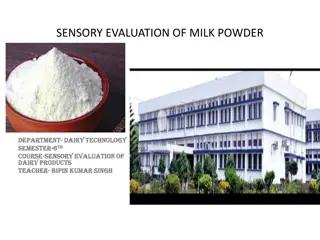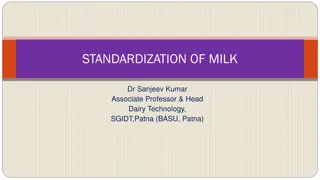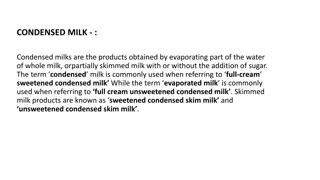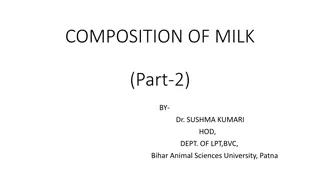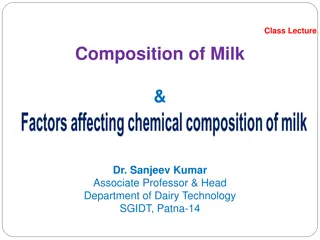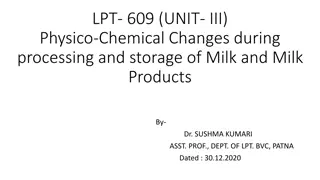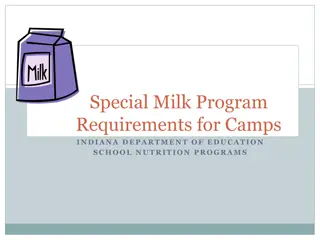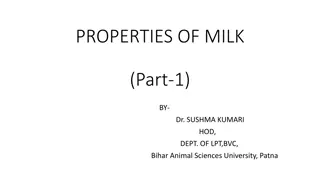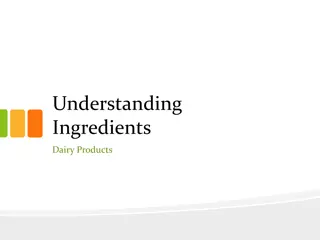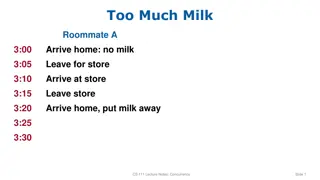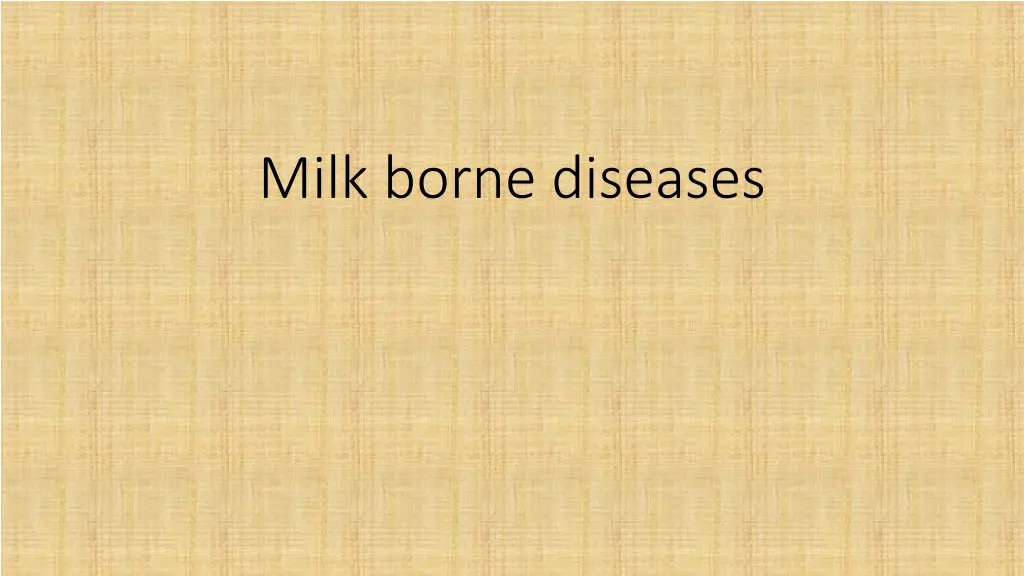
Understanding Milk-borne Diseases and Food Contamination
Learn about milk-borne diseases, how milk can be a medium for harmful microorganisms, and the events of food-borne illnesses like food infection, intoxication, and toxi-infection. Explore the risks associated with bacterial infections, preventive measures, and the causative agents of diseases transmitted through milk and food contamination.
Download Presentation

Please find below an Image/Link to download the presentation.
The content on the website is provided AS IS for your information and personal use only. It may not be sold, licensed, or shared on other websites without obtaining consent from the author. If you encounter any issues during the download, it is possible that the publisher has removed the file from their server.
You are allowed to download the files provided on this website for personal or commercial use, subject to the condition that they are used lawfully. All files are the property of their respective owners.
The content on the website is provided AS IS for your information and personal use only. It may not be sold, licensed, or shared on other websites without obtaining consent from the author.
E N D
Presentation Transcript
Milk constitutes an excellent culture and protection medium for certain micro- organisms causing serious health problems to the consumers. Milk may serve not only as a vehicle of transmission of disease causing organisms, but it can also allow these pathogens to grow, multiply & produce certain toxic metabolities, which are extremely hazardous to public health. The pathogenic organisms may gain entry into milk and milk products during their production, processing, storage and distribution. The organisms may cause food-borne illnesses which may be: 1) food infection 2) food intoxication. 3) food toxi-infection
EVENTS OF FOOD BORNE DISEASES Viral or Parasitic infection Reservoir of Pathogen Contamination of food Growth of pathogenic bacteria Food+ Live cells Food +Toxin Mycotoxin Intoxication Infection Invasive Infection Toxicoinfection
Food infection. The ingestion of viable pathogenic bacteria alongwith the food leads to their lodgement and establishment in consumers organ. This is called as Foodinfection . Food intoxication. Ingestion of toxins already produced by microorganisms in the food brings about poisoning syndromes in the consumers. This is called as Food intoxication . Toxi-infection. A certain group of organisms which can infect intestines when ingested alongwith the food and produce toxins in situ to bring about symptoms of poisoning. This condition is called as toxi-infection .
Invasive Infection Toxicoinfection Intoxication o Salmonella o Bacillus cereus (Diarrhoel) o L. monocytogenes o E. coli ( enteric type) o Staph. Aureus o Cl.botulinum ( Infant) o Cl . perfringens o B.Cereus (Emetic type) o Shigella o Campylobacter o Cl. botulinum o Vibrio cholarae o Yersinia o E. Coli (Enterotoxigenic) o Vibrio parahaemolyticus o Aeromonas
Disease and causative agent Sources contamination to milk and products of Prevention Control and Health effects / Symptoms Diagnosis milk Proper by deep burial with disinfection Total incineration of carcasses Disinfection animal products, wool and hair. Dust control in factories, Vaccination animals and high risk medical care and management. Bacterial infections. 1. Anthrax Infected and contaminated environment animal 1. Cutaneous form :- Appearance of small faruncles within 12-24 h of infection on face, head, hand, leg and neck. 1. Clinical symptoms and from history. 2. Isolation demonstration organism. 3. Guinea inoculation. 4. haemagglutination test (IHA). 5. Fluorescent Antibody Techniques (FAT) 6. Ascoli s precipitation test. disposal and of Bacillus anthracis unopened 2. Pulmonary form :- Pneumonia which may end fatal. pig of Indirect 3. Intestinal form :- Haemorrhagic enteritis with multiple carbuncles are produced. of persons,
Infected animal, Contaminated environment, Personnel handling milk and animals. Acute or chronic undulant fever, Head ache, Sweating and pain in the joints and muscle, Lymph adenitis, Hepatitis, Osteomyelitis. Direct culture techniques, Guinea pig inoculation, Serological like agglutination, milk ring complement fixation test (CFT), 2-mer-capto ethanol coomb s test, ELISA. Pasteurization of milk Vaccination of animals and high risk persons, Eradication by test and slaughter of infected animals, Health education. 2. Brucellosis Brucella abortus B. melitensis B. suis tests test, test,
Faecal contamination, polluted water, Infected animals and man. Direct culture of faeces, blood and spinal fluid, Demonstration by Dark field microscopy, animal inoculation, passive haemagglutinat ion test. Personal hygiene, cleanliness in milk handling, Effective pasteurization of milk, proper treatment of public water supplies therapy. 3. Campylobacteriosis Campylobacter jejuni Acute gastroenteritis characterized by head ache, diarrhoea, abdominal cramps and fever.
Human carriers, Infected animals, Contaminated dairy environment. Fever, Malaise, Cough, Chest Pain, Tonsilitis, Pharyngitis, Pneumonia, Lymphadenitis, Endocarditis, Nephritis, Abscesses, Otitis and Ulcer. Isolation and identification of organisms, Serological tests. Adequate heat treatment of milk, Personal hygiene, Proper vaccination . 4. Diphtheria Corynebacterium diphtheriae
Infected animals through infected udder, Personal handlers, Faecal contamination, Contaminated refrigerators and dish cloths. Abortion and perinatal disease, Encephalitis or meningoencephalitis Septicaemia Occuloglandular form, Granulomatous form, Neonatal meningitis leads to hydrocephalus. Isolation and identification of organism, Mice inoculation, Serological tests like CFT, ELISA and Anton test. Avoidance of reservoirs by pregnant women or immuno deficient persons, Good environmental hygiene, Pasteurization of milk, Immunization of sheep with live vaccine 5. Listeriosis Listeria monocytogenes
Water, Personal carriers, Infected animals, Arthropods. Typhoid fever characterized by severe fever, enteritis, ulcer, spleenomegaly and toxaemia. Paratyphoid fever and salmonella food poisoning with nausea vomiting, abdominal pain, diarrhoea, headache etc. Signs and symptoms, Isolation of organisms, Serological tests like agglutination test, FAT, serotyping and Phage typing. Adequate treatment of water supply, Proper disposal of effluent, Strict hygiene during production, processing storage of milk and products, Pasteurization of milk, Control of flies. Treatment of the affected and Immunization of population at risk. 6. Salmonellosis Salmonella typhi S. paratyphi S. enteritidis S. weltiverdin
Contaminated water, Utensils, Milk handlers (carriers), Flies. Acute characterized by diarrhoea with blood and pus, Fever Vomiting, Abdominal cramps, Tenesmus. Laboratory culture Serologic typing Strict personal and environmental hygiene , Proper water supply and waste disposal, Food protection, Education Supervision of food handlers, Fly control. 7. Shigellosis Shigella dysenteriae S. sonnei intestinal disease
Faecal contamination human carriers, infected animals and milking machines contaminated with organism. Septic sore throat, scarlet fever, puerperal fever, erysipelas, ulcerative endocarditis rheumatic fever. Enterococci can produce food poisoning. Cultural identification, immuno fluorescent technique and other serological testing, serotyping. Early diagnosis and chemotherapy, personal hygiene and disinfection, milk hygiene, pasteurization, mastitis control, holding milk at low temperature. 8. Streptococcosis Streptococcus pyogenes, Group D streptococcus (enterococci)
Infected animals and man, contaminated feed, water and environment, birds droppings. Pulmonary disease, cervical adenitis, genitourinary disease, bone and joint disease, or meningitis. Direct microscopic and cultural techniques, Guinea pig inoculation, radiography, intradermal tuberculin test, polymerase chain reaction Early diagnosis and treatment in man, test and slaughter in animals, pasteurization of milk keep infected people away from cattle, pigs and dogs, BCG vaccination. 9. Tuberculosis Mycobacterium tuberculosis M. bovis M. avium
Contaminated water supply, cross contamination in the kitchen Acute gastroenteritis with diarrahoea, vomiting, fever, headache, hypotension and cyanosis. Laboratory culture technique, serotyping, Kanagawa test (haemolysis) Avoid contamination of water supply and strict water hygiene, application of good sanitary practices and personal hygiene to prevent cross contamination. 10. Vibrio para- haemolyticus infection. V. parahaemolyticus
11. Yersiniosis Yersinia enterocolitica Y. pseudotuberculosis. Faecal contamination, infected personal handlers, contaminated water. Acute right gastric syndrome with ileitis, colonic peritonitis, occasionally appendicitis, septicaemia, arthritis and diarrhoea. Cultural examination, serological like agglutination and ELISA, sero typing Hygiene to protect water and from contamination, avoid contamination, handling products by infected personnel faecal contamination. splenic abscesses, cholecystitis, resembling and food animal tests faecal rarely reactive of the and
Rickettsial disease. Q fever Coxiella burnetti Infected animal. contaminated materials and environment. Infected milk handlers. Generalized febrile illness with pneumonia, myalgia, weakness, hepatitis, spleenomegaly and endocarditis. Signs symptoms, cultural examination, serological tests like micro agglutination, CFT, IFT, radio Isotope precipitation, Luotocapillary agglutination test on milk. Pasteurization of milk, personal protection when handling infected animals especially during parturition, apply face masks when working in contaminated environment immunization, health education.
Viral Diseases. Polio myelitis Polio virus Faecal contamination, infected handlers, Flies. Gastro intestinal disturbances in the beginning followed by headache, fever, muscle stiffness and paralysis mainly of lower extremities, pharynx and death due paralysis. Isolation Serological CFT, HI test. of tests virus. like Pasteurization milk, treatment of water, avoid faecal contamination, strict hygiene, education immunization. of to respiratory health and
Infectious hepatitis Hepatitis A virus Milk handlers, water supply, environment. Sudden onset with fever, anorexia, malaise, nausea, diarrhoea, dark colored urine and jaundice. Signs symptoms, blood analysis to detect elevated glutamic transaminases liver biopsy demonstrate hepatic demonstration by Electron microscope, serological tests. and Adequate treatment of milk, boiling of drinking water, hygiene, faecal contamination, health and Immunization. heat polluted better avoid to damage, education
Tick encephalitis. Group B Arbo virus borne Infected contaminated environment animals, Biphasic meningio encephalitis Signs demonstration serological tests and symptoms. of virus, Adequate treatment of milk, immunization milch animal. heat of
Foot and mouth disease Foot and mouth disease virus Infected animal, Contaminated materials Fever, swallowing, dryness in mouth followed by eruption of blisters in mouth and rarely on fingers. difficulty heat in Signs and symptoms . Mice inoculation. CFT, ELISA. Adequate heat treatment of milk, avoid close contact with animals at the height of infection, disinfection of the premises, equipment and vehicles, immunization. and
Milk infections. borne toxi Infected contaminated utensils, equipment soil animal, Toxins lecithinase and enterotoxin. B. cereus produce two types of poisoning called diarrhoeal type and vomiting type. Symptoms are nausea, vomiting, diarrhoea and abdominal pain. include haemolysin, Signs symptoms Demonstration of organism by cultural techniques. and Prompt cooling of milk and products, better environmental hygiene to prevent aerial contamination, better during production and processing of milk. 1.Bacillus cereus poisoning. and hygiene
2. Clostridium perfringens poisoning Contaminated water. contamination, contaminated environment. Entero toxins - A,B,C,D & E, A & C are more pathogenic produce gastro enteritis characterized diarrhoea, nausea and abdominal pain. Signs symptoms, cultural techniques . and Proper treatment of milk, after pasteurization a rapid cooling and storage of milk at temperature below 15 C is required. heat faecal by vomiting,
Milk borne intoxications Bacterial Contaminated soil and water Toxins A,B,C1,C2,D,E,F,G Gastro enteritis with nausea, vomiting, headache, fatigue, dryness of skin, mouth and throat, paralysis of muscle, double vision, and respiratory failure leading to death. Incubation Period - 8-24 h. Microscopic examination, Cultural techniques and animal inoculation. Adequate heating at 100 C for 10-20 min., hygienic measures during production and rapid chilling, after production, rejection of buldged cans and spoiled foods. 1. Botulism. Clostridium botulinum
2. Cholera Vibrio cholerae Contaminated water, personal carriers and infected persons. Enterotoxin gastrointestinal problems associated with diarrhoea, vomiting, rice water stools, abdominal pain, thirst, dehydration symptoms leading to death. I.P. - 3 days. Isolation and Identification of organism, Guinea pig inoculation. Pasteurization of milk and milk products, water treatment, sanitary disposal of contaminated materials and proper disinfection, Isolation of carriers and immunization.
3. E. coli poisoning Faecal contamination, milk handlers, Infected animals and environment. Heat labile (LT) and Heat stable (ST) entero toxins. LT toxin produce food poisoning resembles cholera characterized by watery diarrhoea. ST toxin symptoms diarrhoea, without vomiting and fever. I.P. 8-24 h. Cultural techniques. Animal inoculation demonstration of toxin production. Avoid contamination and proper treatment of water, personal and environmental hygiene. water Escherichia (ETEC) coli contaminated which for good hygiene those of produce like or with
Staphylococcal poisoning. Human handlers, since the organism is normally present in nose, skin, wounds, pimples and boils, milch harboring the organism in udder. Entero toxins - A,B,C1, C2, C3, D, E and F. Food poisoning characterized by nausea, vomiting, abdominal cramps, diarrhoea, sweating, headache and prostration. I.P. - 1-6 h. Signs symptoms, culture techniques, demonstration of toxins by animal inoculation, serological methods, coagulase test and thermonuclease test. and Adequate of milk immediately to avoid production, adequate immediately production, education applicati better hygiene in handling milk and products. heating toxins Staphylococcus aureus animal cooling after health and on personal of milk
Fungal intoxication 1. Aflatoxicosis Aspergillus flavus A. parasiticus Contaminate d environment, contaminate d foods. Aflatoxin - B1, B2, B2a, M1, M2, G1, G2 and G2 a. Animal inoculation, serological like precipitation and ELISA, radiological examination Prevent contamination milk and products, proper storage of food products avoid fungal growth, detoxication aflatoxins by physical chemical biological agents. of tests Liver anorexia, hepatitis and finally death in animal. hyperplasia, tissue haemorrhage, to of The vital organs like spleen, pancreas and kidney may also be involved in aflatoxicosis. and
Some other mycotoxins include ochratoxin produced by Aspergillus ochraceus, Penicillium viridicatum Fusaro toxin T-2 produced by Fusarium species of fungi Citreo viridin, citrinin, Luteoskyrin penicillic acid, cyclo piazonic acid, roquefortin, camembertin, rubratoxin etc. produced by Penicillium species of fungi.
The Milk borne infections of uncertain pathogenesis include bacterial infections by Aeromonas hydrophila, Citrobacter freundii, Proteus vulgaris and Klebsiella pneumoniae and protozoan infectionby Toxoplasma gondii.


